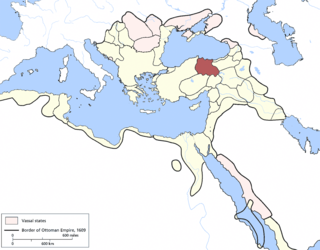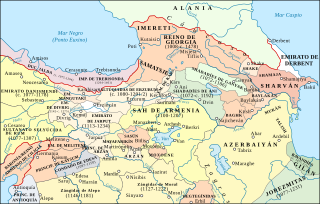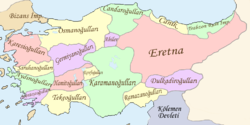Turkmen, Türkmen, Turkoman, or Turkman may refer to:

The Eyalet of Rûm, later named as the Eyalet of Sivas, was an eyalet of the Ottoman Empire in northern Anatolia, founded following Bayezid I's conquest of the area in the 1390s. The capital was the city of Amasya, which was then moved to Tokat and later to Sivas. Its reported area in the 19th century was 28,912 square miles (74,880 km2).

The Karamanids, also known as the Emirate of Karaman and Beylik of Karaman, was one of the Anatolian beyliks, centered in South-Central Anatolia around the present-day Karaman Province. From the mid 14th century until its fall in 1487, the Karamanid dynasty was one of the most powerful beyliks in Anatolia.

The Candar dynasty, also known as the Isfendiyar dynasty, was an Oghuz Turkic princely Anatolian dynasty that reigned in the territories corresponding to the provinces of Eflani, Kastamonu, Sinop, Zonguldak, Bartın, Karabük, Samsun, Bolu, Ankara and Çankırı in present-day Turkey from the year 1291 to 1461. The region was known in Western literature as Paphlagonia, a name applied to the same geographical area during the Roman period.

Anatolian beyliks were small principalities in Anatolia governed by beys, the first of which were founded at the end of the 11th century. A second and more extensive period of establishment took place as a result of the decline of the Seljuq Sultanate of Rûm in the latter half of the 13th century.

The Danishmendids or Danishmends was a Turkoman beylik that ruled in north-central and eastern Anatolia from 1071/1075 to 1178. The dynasty centered originally around Sivas, Tokat, and Niksar in central-northeastern Anatolia, they extended as far west as Ankara and Kastamonu for a time, and as far south as Malatya, which they captured in 1103. In early 12th century, Danishmends were rivals of the Seljuk Sultanate of Rum, which controlled much of the territory surrounding the Danishmend lands, and they fought extensively against the Crusaders.

The Germiyanids was a prominent Anatolian beylik established by the Oghuz Turkish tribes after the decline of Sultanate of Rûm. However, while the beylik was always mentioned as Turkoman or Oghuz Turkish, the population consisted of Turks and Yezidi Kurds, brought by the Seljuks from the east of Malatya to western Anatolia as militia guards against the threatening Turkish tribesmen.

Niksar, historically known as Neocaesarea (Νεοκαισάρεια), is a city in Tokat Province, Turkey. It is the seat of Niksar District. Its population is 37,017 (2022). It was settled by many empires. Niksar is known as "Çukurova of North-Anatolia" due to its production of many kinds of fruits and vegetables. On May 2, 2018, Niksar was included in the World Heritage tentative list.

The Aydinids or Aydinid dynasty, also known as the Principality of Aydin and Beylik of Aydin, was one of the Anatolian beyliks and famous for its seaborne raiding.

Menteshe was the first of the Anatolian beyliks, the frontier principalities established by the Oghuz Turks after the decline of the Seljuk Sultanate of Rum. Founded in 1260/1290, it was named for its founder, Menteshe Bey. Its capital city was Milas (Mylasa) in southwestern Anatolia.

The Shah-Armens, also known as Ahlatshahs or Begtimurids, was a Turkoman Sunni Muslim Anatolian beylik of the Seljuk Empire, founded after the Battle of Manzikert (1071) and centred in Ahlat on the northwestern shore of the Lake Van. This region comprised most of modern-day Bitlis and Van, and parts of Muş provinces.

The Ahi Brotherhood, referred to as Ahi Republic by modern historians, was a fraternity, guild and a beylik based in modern-day Ankara in the 13th and 14th century Anatolia.
Beylik of Dilmaç was a small principality in East Anatolia founded in the 11th century.
Hacı İlbey was an Ottoman commander during the early years of the empire.

Badr al-Din Mahmud was a bey of Karaman Beylik, a Turkoman principality in Anatolia, 14th century.
Musa of Karaman, a.k.a. Hacı Sufi Burhanettin Musa, was a bey of Karaman Beylik, a Turkish principality in Anatolia in the 14th century.
Alaattin Ali of Karaman (d.1397), also Alaeddin Ali, was a bey of Karaman Beylik, a Turkish principality in Anatolia in the 14th century. Like most other Karaman beys, Ali Bey was a rival of the rising Ottoman Empire, and the two principalities engaged in chronic wars against one another.
Şemseddin Yaman Candar, was the eponymous founder and first bey of the Candar dynasty and principality in late 13th century Anatolia. He reigned as Bey of the Principality of Candar from 1291 until his death in 1309.
Beylik of Tacettin was a small Turkmen principality in Anatolia in the 14th and 15th centuries.
Beylik of Hacıemir was a beylik (lordship) in the north Anatolia in a part of 14th and 15th centuries. The historical documents about the beylik are scarce. In some documents the beylik was named Bayramoğulları and in others Hacıemiroğulları. Hacıemir was Bayram's son. In contemporary Greek documents, the name of the beylik was Chalybia, after the ancient Chalybes people who lived in the area.










